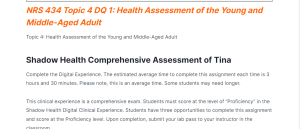NRS 434 Topic 4 DQ 1: Health Assessment of the Young and Middle-Aged Adult

Grand Canyon University NRS 434 Topic 4 DQ 1: Health Assessment of the Young and Middle-Aged Adult-Step -By-Step Guide
This guide will demonstrate how to complete the Grand Canyon University NRS 434 Topic 4 DQ 1: Health Assessment of the Young and Middle-Aged Adult assignment based on general principles of academic writing. Here, we will show you the A, B, Cs of completing an academic paper, irrespective of the instructions. After guiding you through what to do, the guide will leave one or two sample essays at the end to highlight the various sections discussed below.
How to Research and Prepare for NRS 434 Topic 4 DQ 1: Health Assessment of the Young and Middle-Aged Adult
Whether one passes or fails an academic assignment such as the Grand Canyon University NRS 434 Topic 4 DQ 1: Health Assessment of the Young and Middle-Aged Adult depends on the preparation done beforehand. The first thing to do once you receive an assignment is to quickly skim through the requirements. Once that is done, start going through the instructions one by one to clearly understand what the instructor wants. The most important thing here is to understand the required format—whether it is APA, MLA, Chicago, etc.
After understanding the requirements of the paper, the next phase is to gather relevant materials. The first place to start the research process is the weekly resources. Go through the resources provided in the instructions to determine which ones fit the assignment. After reviewing the provided resources, use the university library to search for additional resources. After gathering sufficient and necessary resources, you are now ready to start drafting your paper.
How to Write the Introduction for NRS 434 Topic 4 DQ 1: Health Assessment of the Young and Middle-Aged Adult
The introduction for the Grand Canyon University NRS 434 Topic 4 DQ 1: Health Assessment of the Young and Middle-Aged Adult is where you tell the instructor what your paper will encompass. In three to four statements, highlight the important points that will form the basis of your paper. Here, you can include statistics to show the importance of the topic you will be discussing. At the end of the introduction, write a clear purpose statement outlining what exactly will be contained in the paper. This statement will start with “The purpose of this paper…” and then proceed to outline the various sections of the instructions.

Struggling to Meet Your Deadline?
Get your assignment on NRS 434 Topic 4 DQ 1: Health Assessment of the Young and Middle-Aged Adult done on time by medical experts. Don’t wait – ORDER NOW!
How to Write the Body for NRS 434 Topic 4 DQ 1: Health Assessment of the Young and Middle-Aged Adult
After the introduction, move into the main part of the NRS 434 Topic 4 DQ 1: Health Assessment of the Young and Middle-Aged Adult assignment, which is the body. Given that the paper you will be writing is not experimental, the way you organize the headings and subheadings of your paper is critically important. In some cases, you might have to use more subheadings to properly organize the assignment. The organization will depend on the rubric provided. Carefully examine the rubric, as it will contain all the detailed requirements of the assignment. Sometimes, the rubric will have information that the normal instructions lack.
Another important factor to consider at this point is how to do citations. In-text citations are fundamental as they support the arguments and points you make in the paper. At this point, the resources gathered at the beginning will come in handy. Integrating the ideas of the authors with your own will ensure that you produce a comprehensive paper. Also, follow the given citation format. In most cases, APA 7 is the preferred format for nursing assignments.
How to Write the Conclusion for NRS 434 Topic 4 DQ 1: Health Assessment of the Young and Middle-Aged Adult
After completing the main sections, write the conclusion of your paper. The conclusion is a summary of the main points you made in your paper. However, you need to rewrite the points and not simply copy and paste them. By restating the points from each subheading, you will provide a nuanced overview of the assignment to the reader.
How to Format the References List for NRS 434 Topic 4 DQ 1: Health Assessment of the Young and Middle-Aged Adult
The very last part of your paper involves listing the sources used in your paper. These sources should be listed in alphabetical order and double-spaced. Additionally, use a hanging indent for each source that appears in this list. Lastly, only the sources cited within the body of the paper should appear here.
Stuck? Let Us Help You
Completing assignments can sometimes be overwhelming, especially with the multitude of academic and personal responsibilities you may have. If you find yourself stuck or unsure at any point in the process, don’t hesitate to reach out for professional assistance. Our assignment writing services are designed to help you achieve your academic goals with ease.
Our team of experienced writers is well-versed in academic writing and familiar with the specific requirements of the NRS 434 Topic 4 DQ 1: Health Assessment of the Young and Middle-Aged Adult assignment. We can provide you with personalized support, ensuring your assignment is well-researched, properly formatted, and thoroughly edited. Get a feel of the quality we guarantee – ORDER NOW.
Sample Answer for NRS 434 Topic 4 DQ 1: Health Assessment of the Young and Middle-Aged Adult Included After Question
Topic 4: Health Assessment of the Young and Middle-Aged Adult
You have provided an outstanding work. Indeed, the American society is highly culturally and religiously diverse. Culture is an intricate concept, which entails values, beliefs, behaviors, and how people understand their world. In health care system, managing cultural differences is crucial for provision of high-quality health care.  NRS 434 Topic 4 DQ 1
NRS 434 Topic 4 DQ 1
A Sample Answer For the Assignment: NRS 434 Topic 4 DQ 1: Health Assessment of the Young and Middle-Aged Adult
Title: NRS 434 Topic 4 DQ 1: Health Assessment of the Young and Middle-Aged Adult
Culture has a great influence on how patients respond to illness and treatment. In this multicultural society, various customs may cause confusion and misunderstanding in health care provision, which may compromise trust and compliance among patients (Wakefield et al., 2021). NRS 434 Topic 4 DQ 1
Dealing with patients’ unique religious and cultural needs can be challenging. It is possible to accidentally offend patients or their families by being unaware of their cultural practice (Sharifi et al., 2019).
Moreover, daily routines in the society such as eye contacts, health-beliefs, compliments, non-verbal communication, personal space, decision-making, modesty, and health care practices tend to differ significantly between cultures and religions.
NRS 434 Topic 4 DQ 1
As such, when conducting patient interview, it is important to be aware of patient-specific cultural and religious practices and values (Brooks & Hopkins, 2017). Moreover, nurses should be aware of their cultural identifications to enable them control their personal bias that may compromise therapeutic relationship.
NRS 434 Topic 4 DQ 1: Health Assessment of the Young and Middle-Aged Adult References
Brooks, R. T., & Hopkins, R. (2017). Cultural mistrust and health care utilization: The effects of a culturally responsive cognitive intervention. Journal of Black Studies, 48(8), 816-834. https://doi.org/10.1177/0021934717728454
Sharifi, N., Adib-Hajbaghery, M., & Najafi, M. (2019). Cultural competence in nursing: A concept analysis. International journal of nursing studies, 99, 103386. https://doi.org/10.1016/j.ijnurstu.2019.103386NRS 434 Topic 4 DQ 1
Wakefield, M., Williams, D. R., & Le Menestrel, S. (2021). The future of nursing 2020-2030: Charting a path to achieve health equity. National Academy of Sciences.
A Sample Answer For the Assignment: NRS 434 Topic 4 DQ 1: Health Assessment of the Young and Middle-Aged Adult
Title: NRS 434 Topic 4 DQ 1: Health Assessment of the Young and Middle-Aged Adult
Shadow Health Comprehensive Assessment of Tina NRS 434 Topic 4 DQ 1
Complete the Digital Experience. The estimated average time to complete this assignment each time is 3 hours and 30 minutes. Please note, this is an average time. Some students may need longer.
This clinical experience is a comprehensive exam. Students must score at the level of “Proficiency” in the Shadow Health Digital Clinical Experience. Students have three opportunities to complete this assignment and score at the Proficiency level. Upon completion, submit your lab pass to your instructor in the classroom.
NRS 434 Topic 4 DQ 1
Students successfully scoring within the Proficiency level in the Digital Clinical Experience on the first attempt will earn a grade of 150 points; students successfully scoring at the Proficiency level on the second attempt will earn a grade of 135 points; and students successfully scoring at the Proficiency level on the third attempt will earn a grade of 120 points.
 Students who do not pass the performance-based assessment by scoring within the Proficiency level in three attempts will receive a failing grade (102 points).
Students who do not pass the performance-based assessment by scoring within the Proficiency level in three attempts will receive a failing grade (102 points).
Please review the assignment in the Health Assessment Student Handbook in Shadow Health prior to beginning the assignment to become familiar with the expectations for successful completion.NRS 434 Topic 4 DQ 1
If Proficiency is not achieved on the first attempt it is recommended that you review your answers with the correct answers on the Experience Overview page. Review the report by clicking on each tab to the left titled;
Transcript, Subjective Data Collection, Objective Data Collection, Documentation, and SBAR to compare your work. Reviewing this overview and course resources may help you improve your score.
You are not required to submit this assignment to LopesWrite.
ORDER NOW FOR AN PLAGIARISM FREE, GRAMMATICALLY EXCELLENT PAPER: Topic 4: Health Assessment of the Young and Middle-Aged Adult
Topic 4 DQ 1
You are admitting a 19-year old female college student to the hospital for fevers. Using the patient information provided, choose a culture unfamiliar to you and describe what would be important to remember while you interview this patient.
Discuss the health care support systems available in your community for someone of this culture. If no support systems are available in your community, identify a national resource
Topic 4 DQ 2
For the middle-aged adult, exercise can reduce the risk of various health problems. Choose two at-risk

health issues that regular physical exercise and activity can help prevent and manage. Discuss the prevalence of each of these health problems in society today.
Describe measures that you would take as a nurse to assist clients with health promotion measures to incorporate exercise and physical activity into their lives.
Include the kind of activities you would recommend, the amount of exercise, and the approach you would use to gain cooperation from the client. Support your response with evidence-based literature.
Re: Topic 4 DQ 2
The middle-aged adult has past the peak his physical maturity. He starts to notice declinations of some body systems such as vison, hearing, and physical strength. Disease processes may begin to manifest. (Green, s., Falkner, A., 2018).
To combat diseases a healthy diet using guidelines of the healthypeople.gov/ website and exercise are most effective. Two very common health risk factors that effect this age group are over-weightiness and osteoporosis.
A Sample Answer 3 For the Assignment: NRS 434 Topic 4 DQ 1: Health Assessment of the Young and Middle-Aged Adult
Title: NRS 434 Topic 4 DQ 1: Health Assessment of the Young and Middle-Aged Adult
Osteoporosis is a common problem among adult women. According to HealthyPeople.gov., 5.3 million middle-aged people are affected (Healthypeople, 2019).
The National Osteoporosis Foundation reports that one in two women and one in four men are affected by it. With osteoporosis, the patient will have a decrease in bone and bone tissue. This makes the patient more susceptible to fractures. Though this bone condition may be inherited, for many, it is modifiable through nutrition and exercise.
Over-weightiness is another very common problem among middle-aged adults. It increases the risks of developing many other health problems such as; high blood pressure, stroke, diabetes II, coronary artery disease, colon cancer, and sleep apnea to name a few. (Healthy weight, 2015).
Over-weight is defined as a body mass index of 25 or more According to the CDC, between 2015-2016, the number of overweight adult aged 20 and higher was 71.6%. This is modifiable through nutrition and exercise.
Osteoporosis patients should be encouraged to get routine screenings called peripheral tests, where bone density tests measured in the lower arm, wrist, finger or heel is conducted. The nurse should stress the importance of load-bearing exercises and balance and strength training 3 or more times a week. NRS 434 Topic 4 DQ 1: Health Assessment of the Young and Middle-Aged Adult. Exercises such as swimming and walking are good for more fragile patients.
These patients will benefit from simple yoga poses that strengthen good body posture which is a challenge for these patients. The nurse can encourage the patient to join the local YMCA where they have good senior discounts.
The National Osteoporosis Foundation website has examples of Isometric exercise to benefit posture and balance. There are also many senior groups that come together weekly to walk through malls and parks for exercise and socializing. The nurse is the facilitator of good habits, but it is ultimately up to the patient to take initiative.
To lose weight, the patient will need to change their eating habit along with exercise. This patient needs to do aerobic exercise at least 30 minutes per day. This can be walking, bicycling, a step class or something the patient enjoys. Performing with moderate to high intensities will keep the heart pumping more intensely for an aerobic workout.
For example, the patient could go for a run. He could run for 3 minutes and walk fat a fast pace for or 5 minutes and continue to switch and even vary the minutes he performs each set.
The nurse will want to remind both patients that the key to being successful in managing osteoporosis or losing weight is getting started and having the mental attitude that their health is a priority and exercise is a big part of it. Recommend they change things up. Try different types of aerobics and try a new surrounding to fight boredom.
Encourage them to have fun, because if they enjoy what they are doing, they are more likely to stay with it. Tell them to find a friend or family member who will exercise with them. Having a partner may makes the patient feel more accountable. Lastly, encourage them to set goals and give themselves healthy rewards for meeting them.
References
Arthritis, osteoporosis, and chronic back conditions. (2019). HealthyPeople.gov. Retrieved from https://www.healthypeople.gov/2020/topics-objectives/topic/arthritis-osteoporosis-and-chronic-back-conditions
Healthy weight: The health effects of overweight and obesity. (2015). Centers for Disease Control and Prevention. Retrieved from https://www.cdc.gov/healthyweight/effects/index.htm
What is osteoporosis and what causes It. (2019). National Osteoporosis Foundation. Retrieved from https://www.nof.org/patients/what-is-osteoporosis/
A Sample Answer 4 For the Assignment: NRS 434 Topic 4 DQ 1: Health Assessment of the Young and Middle-Aged Adult
Title: NRS 434 Topic 4 DQ 1: Health Assessment of the Young and Middle-Aged Adult
Cultural competence and cultural awareness is needed in nursing especially when gathering information and assessing a patient to effectively ” empower and promote health” (Grand Canyon University, 2018). This sensitivity and respect to the patients enables the nurse to have a therapeutic assessment and a trusting relationship with the patient.
For example, when caring for a 19 year old female with Muslim faith, it is important to know the specifics of the culture to provide the appropriate care. Muslim faith with Islamic beliefs that women must only be seen by female health care providers to protect privacy and to minimize eye contact especially from the opposite sex (Attum, et. al. 2021).
Also “for Muslims, the belief of illness is a test from God and it is a trial for removal of sin, therefore when ill they may call for spiritual intervention (Attum, et. al, 2021). For nurses unfamiliar with the culture, it may be a good advice to inquire with the patient or any accompanying family their cultural norms and how they can be treated with respect and without judgement.
The Islamic Center of San diego and the Muslim community Services of San Diego are two community resources that provide valuable resources and information regarding the cultural norms.
Reference:
Attum B, Hafiz S, Malik A, et al. Cultural Competence in the Care of Muslim Patients and Their Families. [Updated 2021 Sep 6]. In: StatPearls [Internet]. Treasure Island (FL): StatPearls Publishing; 2022 Jan-. Available from: https://www.ncbi.nlm.nih.gov/books/NBK499933/
Grand Canyon University (Ed). (2018). Health promotion: Health & wellness across the continuum. Retrieved from https://lc.gcumedia.com/nrs429vn/health-promotion-health-and-wellness-across-the-continuum/v1.1/
A Sample Answer 5 For the Assignment: NRS 434 Topic 4 DQ 1: Health Assessment of the Young and Middle-Aged Adult
Title: NRS 434 Topic 4 DQ 1: Health Assessment of the Young and Middle-Aged Adult
Culture plays a significant role in healthcare delivery. Nurses need to exhibit culturally competent care by asking about the patients’ cultural backgrounds to ensure appropriate and effective care delivery. Hindu’s hold their culture in high esteem, and it is essential to recognize that when admitting a young Hindu.
Through this, the nurse can include the Hindu culture in the plan of care to ensure culturally competent care is delivered (Falkner, 2018). The Hindu culture recognizes family in healthcare decision-making. The family member who will help in decision-making should be clarified. Whether Western or Ayurvedic treatments, the patient preference of treatment should be enquired. The complete list of medications should be asked.
Does she use herbal medicine?. This will help to avoid drug-drug interactions. Knowing how the patient handles pain will also be essential (Queensland Health, 2021). The nurse would ask the patient the gender she prefers to take care of her. They usually ask for same-gender healthcare professionals because of modesty.
As a nurse, asking how she will want to keep her sacred items and how she would like to pray while on admission is vital. Asking about the diet restrictions or if the patient is a vegetarian is also essential (Swihart et al., 2021).
BHT AAPIO clinic provides free healthcare for Hindus in Columbus, Ohio. It is a team of doctors and nurses who has come together with support from the Bharatiya Hindu temple. They provide acute health services, prescriptions, lab work, electrocardiogram, and Pulmonary function tests (BHT clinic, n.d.). This place serves as one of the comfortable places where they get care according to their religious practices.
NRS 434 Topic 4 DQ 1: Health Assessment of the Young and Middle-Aged Adult References
BHT clinic. (n.d.). BHT Clinic. https://www.bhtclinic.org/
Falkner, A. (2018). Cultural awareness. In Grand Canyon University (Eds.), Health promotion:
Health & wellness across the continuum. https://lc.gcumedia.com/nrs429vn/health-promotion-health-and-wellness-across-the-continuum/v1.1/#/chapter/3
Queensland Health. (2011). Health care providers handbook on Hindu patients. Division of the Chief Health Officer, Queensland Health. Brisbane. https://www.health.qld.gov.au/__data/assets/pdf_file/0024/156255/hbook-hindu.pdf
Swihart, D. L., Yarrarapu, S. N. S., & Martin, R. L. (2021). Cultural religious competence in clinical practice. In StatPearls [Internet]. StatPearls Publishing
A Sample Answer 6 For the Assignment: NRS 434 Topic 4 DQ 1: Health Assessment of the Young and Middle-Aged Adult
Title: NRS 434 Topic 4 DQ 1: Health Assessment of the Young and Middle-Aged Adult
You have provided an outstanding work. Indeed, the American society is highly culturally and religiously diverse. Culture is an intricate concept, which entails values, beliefs, behaviors, and how people understand their world. In health care system, managing cultural differences is crucial for provision of high-quality health care. Culture has a great influence on how patients respond to illness and treatment. In this multicultural society, various customs may cause confusion and misunderstanding in health care provision, which may compromise trust and compliance among patients (Wakefield et al., 2021). Dealing with patients’ unique religious and cultural needs can be challenging. It is possible to accidentally offend patients or their families by being unaware of their cultural practice (Sharifi et al., 2019). Moreover, daily routines in the society such as eye contacts, health-beliefs, compliments, non-verbal communication, personal space, decision-making, modesty, and health care practices tend to differ significantly between cultures and religions. As such, when conducting patient interview, it is important to be aware of patient-specific cultural and religious practices and values (Brooks & Hopkins, 2017). Moreover, nurses should be aware of their cultural identifications to enable them control their personal bias that may compromise therapeutic relationship.
References
Brooks, R. T., & Hopkins, R. (2017). Cultural mistrust and health care utilization: The effects of a culturally responsive cognitive intervention. Journal of Black Studies, 48(8), 816-834. https://doi.org/10.1177/0021934717728454
Sharifi, N., Adib-Hajbaghery, M., & Najafi, M. (2019). Cultural competence in nursing: A concept analysis. International journal of nursing studies, 99, 103386. https://doi.org/10.1016/j.ijnurstu.2019.103386
Wakefield, M., Williams, D. R., & Le Menestrel, S. (2021). The future of nursing 2020-2030: Charting a path to achieve health equity. National Academy of Sciences.

Don’t wait until the last minute
Fill in your requirements and let our experts deliver your work asap.